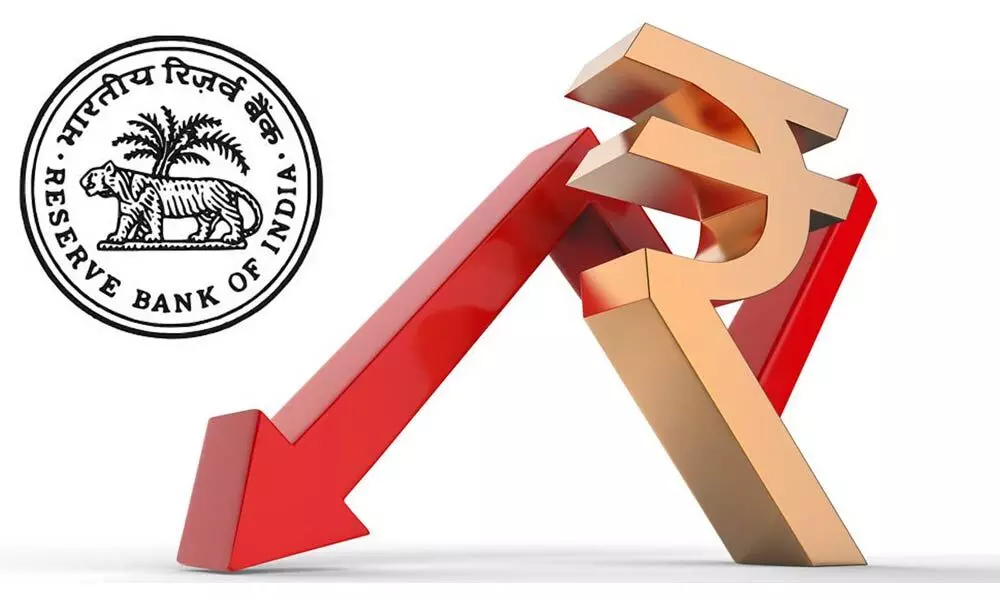Widening trade deficit taking toll on rupee
RBI’s intervention needed to keep it at a particular level, say experts
image for illustrative purpose

RBI trying to flatten the yield curve and absorb short-term liquidity using variable reverse repo and G-SAP. Unwinding of the carry trade likely to weigh which is estimated to be around $40 bn
Mumbai: Rupee might have recouped its early losses to close higher by 12 paise against the dollar at 74.93 on Thursday and gain 58 paise on Friday to close at 74.35, but it is only a temporary relief. The reasons behind rupee's weakening are galore. Some of them include widening trade deficit due to increasing imports and outflows of FPIs from the equity market.
Experts believe that RBI's intervention is needed to ensure that the currency stays around a particular level. Rupee had consolidated in a range between 72.50 and 74.50 over the last seven months. However, recent move pushed the currency to lowest level in six months against the US dollar, says a report by Motilal Oswal Investment Services.
In the recently concluded policy meet on April 07, RBI kept rates unchanged and maintained an accommodative stance. Moreover, the central bank announced secondary market government securities acquisition program - G-SAP 1.0. In this programme, it will purchase Rs 1 trillion worth of bonds from market in the April-June quarter. Purchase of G-SAP could be as high as Rs 3 trillion in the current fiscal year.
RBI is trying to flatten the yield curve and absorb short-term liquidity using variable reverse repo and G-SAP. Unwinding of the carry trade likely to weigh which is estimated to be around $40 billion. As per the study, the central bank would happily welcome marginal rupee depreciation leading to this. This step by RBI is an attempt to bring down yields and that could impact exchange rate or portfolio flows.
Still, the issue was that US is in a fast recovery phase and treasury yields could surge even higher strengthening the dollar. The direction of the rupee is dependent on two factors - trade, and investments. The contribution of trade is not very significant as India's share in global trade is quite negligible. India is a net importer, being a developing country, and our import bill for oil is one of the largest in the world. In the aftermath of the pandemic, India's exports and imports came down, and subsequently exports started picking up, followed by imports with a lag.
After a surplus of three quarters in a row, the current account was in a deficit $1.70 billion in Q3FY21, after a surplus of $15.10 billion in Q2FY21.
The widening trade deficit is the main reason behind this. The capital account in Q3FY21 was an all-time high with balance of payments surplus to the tune of $32.50 billion. This was facilitated mainly by the equity flows of $22 bllion. With increasing imports, the current account deficit is likely to widen. This is likely to put pressure on the currency unless RBI steps in to ensure that the currency stays around a particular level. However, RBI may be comfortable with a gradual weakening of the rupee. "The US bond yields are rising, and the overall rates in the US are set to go up in the light of high inflationary expectations. The USD is likely to strengthen against all major currencies," says K Joseph Thomas, Head - research, wealth management, Emkay Global Financial Services.
Whenever the investment inflows from FPIs have been good, the rupee has strengthened, and whenever we see outflows on account of equity selling, rupee gradually weakens. It is the investment flows that play a crucial role in determining the direction of the currency, Thomas added. On what could rein in the currency weakness, the report by Motilal Oswal Investment Services says that sustained FII flows into equity, strong FDI investment, inflation within the RBI's target at 4 per cent and above all RBI's continued focus on growth. In addition, more stimulus package from US could restrict sharp gains in dollar, thus supporting the rupee. "We can see a 'Bearish channel' candlestick chart pattern formed on 15-Minute chart, and price have closed just above this channel, so we will not expect going long until this breakout is confirmed, as this may also turn into a false breakout and we may witness a steep downfall till the levels of 75.05-74.95. On the upper side, resistance may be tested in the range of 75.25-75.35 for upcoming sessions," says Kshitij Purohit, Product Manager, Currency & Commodities, CapitalVia Global Research.

